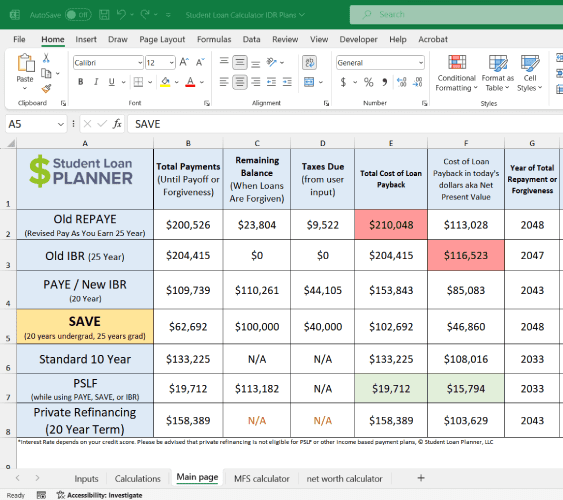
As a Parent PLUS Loan borrower, you might’ve gotten a federal student loan for your child’s education as an act of love. In return, you might’ve gotten a pretty bum deal.
That’s because this type of education loan comes with an interest rate on the high end and limited access to repayment options. Some Parent PLUS borrowers turn to consolidation to qualify for the Income-Contingent Repayment (ICR) plan. It can help, but even under ICR, your student loan payment would be a steep 20% of your discretionary income — double that of other income-driven repayment (IDR) plans.
For some, this is far too high and unmanageable. That’s where the Parent PLUS Loans back-to-school consolidation loophole comes in.
The unconventional Parent PLUS Loans back-to-school consolidation loophole
This loophole is an unconventional strategy for Parent PLUS borrowers who’ve already done a Direct Consolidation Loan for their Parent PLUS debt, but need lower payments. Our team is well-versed in this approach and colloquially refers to it as the “Grandma or Mom goes back to school” loophole.
In this scenario, after consolidating all or some of your Parent PLUS Loans, you’re now left with one Direct Consolidation Loan that lets you access the ICR plan. However, since you have just a single loan, you’re ineligible for the straightforward double-consolidation loophole.
Instead, the “back-to-school” consolidation loophole involves borrowers enrolling in school for some time and taking out additional federal student loans. You might think this is counter-productive, but doing so unlocks the double-consolidation loophole.
Your new student loans and existing Direct Consolidation Loan are combined, and you can then access lower IDR plans, such as the new SAVE plan.
Get Started With Our New IDR Calculator

Step-by-step guide: Back-to-school consolidation for Parent PLUS Loans
The Parent PLUS loans back-to-school consolidation loophole is an advanced strategy that isn’t for everyone. To be effective, here’s what a parent borrower must do:
- Enroll in school. Choose a program or certificate course that interests you, and make sure to enroll for the Fall 2024 session.
- Apply for federal financial aid. Upon applying, accept a federal loan to cover the school’s cost of attendance.
- Maintain the required enrollment status. Enroll in enough classes to meet at least part- or half-time enrollment.
- Keep a satisfactory academic performance. Don’t let your grades slip or skip out on attending classes. Aim for a grade that at least prevents you from being put on academic probation or kicked out. If you fail out of the class or stop attending classes at the beginning of the semester, there might be consequences like compromising your financial aid and being held responsible for tuition costs. Talk to your financial aid office about potential consequences and deadlines.
- Withdraw from school. Even if you plan to continue in the program, temporarily withdraw from school after the end of the semester so you can consolidate your Fall 2024 loans with other existing loans.
- Submit a Direct Consolidation Loan application. This will be for your new federal student loans and past consolidation loan.
- Apply for your second Double Consolidation Loan. Undergo the consolidation process again to access the double-consolidation loophole and the SAVE plan.
- Enroll in the SAVE plan. This plan sets your monthly payments to 10% of discretionary income, and any interest that isn’t covered by your payment is subsidized by the government. For borrowers who are close to retirement, this route can also reduce total costs over the life of the loan.
This isn’t exactly an easy way to lower your monthly payments since you’re strategically borrowing a bit more to pay less in the future. But it’s one off-the-beaten-path way to access the double-consolidation loophole before time runs out.
If you’re interested in the Parent PLUS back-to-school consolidation loophole, you’ll need to pull this off before the July 1, 2025, deadline.
Your window to lock in the SAVE plan is closing soon
The most crucial part of the Parent PLUS Loan back-to-school consolidation loophole is doing it ASAP. All of this effort and expense is to save you money in the long run by accessing other repayment options through double consolidation.
However, the double-consolidation loophole is officially ending on July 1, 2025. If you need to take advantage of this back-to-school consolidation strategy and enroll in school, you likely only have the summer/fall 2024 semesters to make this happen. Spring 2025 is cutting it too close.
Considerations to weigh before reliving a semester on campus
This strategy requires a lot of time and effort, so consider the pros and cons in the short term and long term.
Pros:
- Access to cheaper plans. Going back to school and then doing a double consolidation gives you access to SAVE, which can reduce payments.
- Improve financial well-being. For Parent PLUS borrowers weighed down by high ICR payments, accessing SAVE and other options can help your budget and financial well-being.
Cons:
- Time-intensive. You have to put in the effort to apply to school, submit a FAFSA, and maintain your grades for a full school semester.
- Expires soon. Borrowers must enroll in school ASAP to make sure they can complete the process before July 1, 2025.
- Additional cost. Though this loophole can provide lower payments over time, in the short term, you’re taking on additional costs with another loan.
Alternatives to consider for lower student loan payments
The Parent PLUS Loan back-to-school consolidation loophole is certainly not for everyone. It’s ideal for borrowers who feel they’re at a dead end with ICR and are open to any workaround for a lower monthly payment.
If this process doesn’t appeal to you, here are some alternatives to consider.
- Married borrowers can file taxes separately. If your tax status is married, filing jointly, and you’re on ICR, both your and your spouse’s income is included in the payment calculation. Filing separately can lower your payment amount. There are pros and cons to filing your return under this marital status, so talk to a tax professional.
- Look into student loan refinancing. Refinancing might help you access a lower interest rate, and new repayment terms at a reduced payment. However, this risks losing significant federal benefits like flexible repayment plans and loan forgiveness.
- Request forbearance until retirement. If you’re close to retirement, you can request forbearance to pause your payments. In retirement, your income on your tax return might be low enough to get you a $0 payment. If that continues over the long term, you might see your loans forgiven under ICR in 25 years. Federal loans are also discharged if you pass away during repayment.
Need help with your Parent PLUS Loans? Get support and know your options
Parents who take out loans face multiple financial obligations. Even when consolidating Parent PLUS Loans and choosing ICR, payments can still be high. However, the back-to-school consolidation loophole requires a significant amount of commitment.
If you move forward, time is of the essence with the impending deadline. Discuss how this repayment strategy fits with your overall financial goals by talking to a knowledgeable member of our team. Book a consult with Student Loan Planner.
Refinance student loans, get a bonus in 2024
| Lender Name | Lender | Offer | Learn more |
|---|---|---|---|

|
$500 Bonus
*Includes optional 0.25% Auto Pay discount. For 100k or more.
|
Fixed 5.24 - 9.99% APR*
Variable 6.24 - 9.99% APR*
|
|

|
$1,000 Bonus
For 100k or more. $300 for 50k to $99,999
|
Fixed 5.19 - 10.24% APPR
Variable 5.28 - 10.24% APR
|
|

|
$1,000 Bonus
For 100k or more. $200 for 50k to $99,999
|
Fixed 5.19 - 9.74% APR
Variable 5.99 - 9.74% APR
|
|

|
$1,050 Bonus
For 100k+, $300 for 50k to 99k.
|
Fixed 5.44 - 9.75% APR
Variable 5.49 - 9.95% APR
|
|

|
$1,275 Bonus
For 150k+, $300 to $575 for 50k to 149k.
|
Fixed 5.48 - 8.69% APR
Variable 5.28 - 8.99% APR
|
|

|
$1,250 Bonus
For 100k+, $350 for 50k to 100k. $100 for 5k to 50k
|
Fixed 5.48 - 12.43% APR
Variable 5.28 - 12.43% AR
|
Not sure what to do with your student loans?
Take our 11 question quiz to get a personalized recommendation for 2024 on whether you should pursue PSLF, Biden’s New IDR plan, or refinancing (including the one lender we think could give you the best rate).
